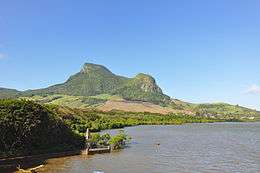Georg Friedrich Wreede
Georg Friedrich Wreede or Georgius Fredericius Wreede (died on 29 February 1672) was governor of Dutch Mauritius from 1665 to 1672, with a break between 1668-1669.


Wreede was born around 1635 in Uetze near Hannover, in Germany. In 1659 he arrived at Cape of Good Hope as an employee of the Dutch East India Company (Dutch: Vereenigde Oostindische Compagnie, commonly abbreviated to VOC). He had been a student in Philology in Helmstedt and within four years of his arrival he had written a compendium using the Greek alphabet on Khoekhoegowab – then called Hottentot – consisting of sentences with Dutch translations.[1] The "list" was sent to Amsterdam, but never published and has disappeared.[2][3]:273–274 Possibly it was sent to Hiob Ludolf, who was a famous linguist, and in contact with Nicolaes Witsen. Christian Juncker published Ludolf's biography with a list of Hottentots-Latin words.[4]
In 1660 he took part in an expedition to the Olifants River.[5] In February 1665 he was sent by Zacharias Wagenaer on an expedition to look if Martin Vaz could be used by ships, and returned in May with charts.[6] The Pimpel went on to Mauritius and Wreede was appointed by the captain as the new governor.[7]:138,162 For three months the twelve men on the island had been without rice or brandy. In October 1668, the captain of the visiting Poelsnip using his discretion relieved Wreede of his duty following formal complaints by his men, and removed him from the island to be held accountable to the VOC for his actions.[8]:23 Dirk Jansz Smient was appointed to replace him.
Wreede was sent to Saldanha Bay where the French East India Company had planned a base, after leaving Madagascar.[9] On 6 June 1669 Georg Wreede took command of the post and brought with him a carpenter. They erected a VOC monogram on each of the five islands in Saldanha Bay. A month later Wreede was transferred.[10] In October 1669 he was back on the island Mauritius.[11]:2[8]:24
Wreede drowned in 1672 while sailing intoxicated.[8]:26[12]:15 He was eventually replaced by Hubert Hugo.
In 1688 Olfert Dapper probably used Wreede's observations but did not mention his source.[13][14]:161
References
- Hesseling, D.C. (1899). Het Afrikaansch [The Afrikaans] (in Dutch) (1st ed.). pp. 22–26. Retrieved 1 March 2020.
- Goodwin, A. J. H. (1952). "Commentary on 'Jan van Riebeeck and the Hottentots'". The South African Archaeological Bulletin. South African Archaeological Society. 7 (26): 86–91. doi:10.2307/3887454. JSTOR 3887454.
- den Besten, Hans (2010). Huigen, Siegfried; de Jong, Jan L.; Kolfin, Elmer; et al. (eds.). "A badly harvested field: The growth of linguistic knowledge and the Dutch Cape colony until 1796". The Dutch Trading Companies as Knowledge Networks. Intersections – Interdisciplinary Studies in Early Modern Culture. Leiden: Koninklijke Brill. 14: 267–294. doi:10.1163/ej.9789004186590.i-448. ISBN 9789004186590. S2CID 161385081.
- Juncker, Christian (1710). Commentarius De Vita, Scriptisque Ac Meritis Illustris Viri Iobi Ludolfi, Consiliarii Quondam Serenissimorum Saxoniae Ducum Intimi, Viri Per Eruditum Orbem Celeberrimi (in Latin). Leipzig and Frankfurt: Braun. OCLC 635203142. Retrieved 1 March 2020.
- "Opgeknapte gastehuis by Citrusdal-warmbron ingewy" [Renovated guest house at Citrusdal hot spring] (in Afrikaans). Archived from the original on 26 November 2015. Retrieved 1 March 2020.
- de Wet, G. C. (2003). "Inventory of the archives of the Secretary, Council of Police, 1649 – 1795" (PDF). Cape Town Archives Repository. Archived from the original (PDF) on 19 November 2008. Retrieved 1 March 2020.
- Cape of Good Hope (South Africa) Archives (1901). Leibbrandt, H. C. V. (ed.). Journal, 1662–1670. Precis of the Archives of the Cape of Good Hope. 14. Cape Town: W. A. Richards & sons.
- Turton, Anthony (2009). "A South African Diary: Contested Identity, My Family – Our Story, Part A: Pre-1700". CiteSeerX 10.1.1.544.9959. Cite journal requires
|journal=(help) - Theal, George MacCall (1897). History of South Africa Under the Administration of the Dutch East India Company, 1652 to 1795 (2nd ed.). London: Swan Sonnenschein & Co. OCLC 25939696. Retrieved 24 February 2020.
- Leonard, Elmarie (n.d.). Athiros, Gabriel (ed.). "Route 27 West Coast South Africa". Avril Brand, South Africa West Coast. Retrieved 1 March 2020.
- Hume, Julian; Winters, Ria (5 February 2015). "Captive birds on Dutch Mauritius: bad-tempered parrots, warty pigeons and notes on other native animals". Historical Biology: An International Journal of Paleobiology. 28 (6): 1–11. doi:10.1080/08912963.2015.1036750. Retrieved 1 March 2020.CS1 maint: date and year (link)
- Pitot, Albert (2000) [1914]. "History". In Macmillan, Allister (ed.). Mauritius Illustrated: Historical and Descriptive, Commercial and Industrial Facts, Figures, & Resources. New Delhi: Asian Educational Services. pp. 11–70. ISBN 9788120615083. OCLC 47863322.
- "Recommended Reading Books of the Early Cape". Archived from the original on 12 December 2010. Retrieved 8 January 2011.
- Parkington, John E. (2009) [Replaces cloth edition originally published in 1984]. "Soaqua and Bushmen: Hunters and Robbers". In Schrire, Carmel (ed.). Past and Present in Hunter Gatherer Studies (illustrated reprint ed.). Walnut Creek: Left Coast Press. ISBN 9781598744576.
Further reading
- Moree, Perry J. (1998). A Concise History of Dutch Mauritius, 1598-1710: A Fruitful and Healthy Land. London: Kegan Paul International. ISBN 9780710306098.
| Preceded by Dirk Jansz Smient |
Governor of Mauritius 1669–1672 |
Succeeded by Hubert Hugo |